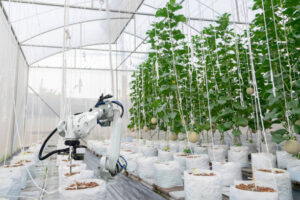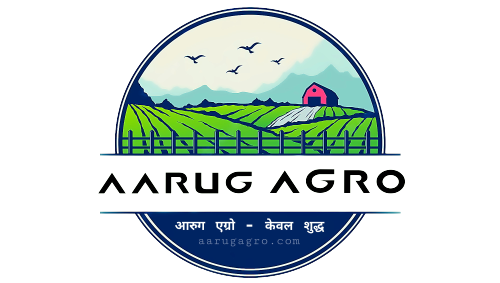Smart Farming in India: Farmers are the backbone of farming, and they have done so since ancient times. Food is produced in the fields by farmers who work hard. Farming used to be a labor-intensive technique that took considerable time and effort in the past. Labor-intensive techniques turn into capital-intensive ones that produce high yields with less effort as time goes by. Farming or agriculture in India must be smart to increase production and income for farmers.
Our farmers depend on the monsoon to sow their crops in this 21st century, when phones are smarter than humans. Indian farming needs to be elevated to a whole new level. The topic of smart farming in India this time is covered with techniques and solutions. Your farm productivity can be increased with fewer efforts if you follow this blog.
Exactly what is Smart Farming?
The first thing we need to know about smart farming is what it is. Smart farming is the best farming technique that utilizes existing farming practices to increase productivity. As a result, farming products were more efficient and of higher quality. This means that smart farming techniques reduce the amount of monotonous and heavy work farmers have to do, thereby enhancing their quality of life.
Basically, smart farming involves reducing waste, increasing productivity, and maximizing resources. Precision farming also refers to smart farming. The process involves using smart farming technologies such as internet of things (IoT), big data analytics, remote sensing, artificial intelligence, and robotics. Science has proven that applying these technologies increases profits, minimises waste, and maintains the quality of the environment.
Smart farming support from the central government
As part of its efforts to develop the agri-tech sector, the Indian government plays an active role. Indian farmers are always empowered by new bills. Smart farming is supported by the Indian government because it reduces workers’ effort and improves productivity. The current goal is to double farmers’ income by 2022. Through smart farming ideas, they hope to increase farmers’ income with minimal effort. A technology-driven solution is developed in collaboration with IBM by the NITI Aayog. To increase crop productivity, these farmers receive real-time advice and financing.
A grant of up to INR 2000 crore will help the government digitize PACS (Primary Agricultural Credit Society). Government-sponsored initiatives that support smart farming include the MANAGE (Managing Agricultural Extension in Hyderabad) program, mentoring of agri-tech start-ups, PMKSY (Pradhan Mantri Krishi Sinchayee Yojana), and One Nation One Market.
Read more:Organic Fertilizers and their Benefits: Organic Vs Inorganic Fertilizers
Is Agri-tech affordable for farmers?
High-tech and technologically advanced products provide comfortable work with high productivity. Farmers will not adopt smart farming if it is not affordable to them. Due to their limited incomes, most Indian farmers are unable to utilize the digital revolution in farming. For start-ups in agri-tech to fully benefit from their products and services, they need to prepare them according to the farmer’s budget.
Enhancing Smart Farming with Innovative Technologies

There is a slight orthodoxy to Indian people. Their belief is that ancient farming methods are best for agriculture. The methods should also change as the population grows and technology advances. Smart farming can only be enhanced by adopting innovative technologies. Following we are showing some technologies which should be enhanced.
Product innovations
A need for innovation exists in products. A product that has grown from olden times and needs to be updated. The market has introduced new technologies that are creating completely new kinds of foods. Lab-grown products are tested when they can’t be grown in nature.
Digital marketplaces
Indian farmers can now use the eNAM facility as a result of a government initiative. Farmers across India can create networks with the eNAM (National Agriculture Market) through an electronic trading portal that connects the existing APMC mandis. Equal access to the agricultural market is its main objective. It promotes real-time price as well as smoothness between buyers and sellers.
The digital marketplace also allows farmers to lease equipment, connect with local customers, or pool insurance resources.
Software for operations
Farmers will be able to make better and more efficient decisions, save money, and track resources and productivity.
Tools for building skills
It is important to build skills in Indian farming. Their ancestors or parents taught them how to produce. These newly introduced technologies aren’t familiar to them. The farmers should be introduced to the latest farming techniques and skill building tools to improve their skills.
There are a variety of services available, including voice hotlines, videos, mobile apps, and others. Farmer sharing and learning are made easier with these tools. Farmers in France can ask questions and seek advice in AgriFind, a social networking site.
The resources
Resources should be utilized to the fullest extent possible. Water and fertilizer are delivered to highly targeted areas in India by new irrigation systems. Vertical farms and urban farms are the best places to use it. Water and soil were used less in these methods. It also reduces pesticide use.
The Smart Farming Idea

It is impossible to separate innovation from smart farming. There are many challenges facing Indian agriculture at the moment. Agriculture needs to be accelerated by smart farming ideas. Agriculture technology investment has grown significantly over the last 10 years. There was $6.7 billion in investment in the last five years, and $1.9 billion in the last year alone. India is investing in these projects to improve its farming methods. This article will provide you with some smart farming ideas that will help you become a smart farmer. Take a look.
Farming vertically indoors
Plants are grown indoors under controlled conditions through vertical farming. The plants are mounted vertically, and it takes less land to grow than traditional farming. Plants grow vertically without soil, and this method reduces the labour force as well. A smart farming technique is the best and the first of its kind in India.
Automated farming
The automation of farming equipment and machines is the upgrade of these machines and equipment. It is a goal that companies are working towards. A number of autonomous tractors, automatic irrigation systems, drones, robotic innovations, and seeding robots are also being developed. Farmers can not only afford these machines because the companies provide quality, innovative machinery.
The technology of livestock farming
The livestock industry in our country is the least understood component of agriculture, despite providing much-needed products. A lot of improvements and changes have occurred to the industry over the past eight to ten years due to new innovations. It is convenient and easy to manage and track livestock with it. Genomics, nutrition, digital technology, and others are among these technologies.
The modern greenhouse
There has been a significant increase in greenhouses in Indian agriculture. The economy is urbanized and capital-driven. In recent years, greenhouse usage has increased as market demand has increased dramatically. Nowadays, greenhouses use LED lights and automated controls, as well as equipment that relies heavily on technology.
Agriculture with precision
Indian farmers are able to boost their production by using precision agriculture technologies introduced by recent companies. A variety of factors contribute to pest control, including pest stress, microclimates, soil moisture levels, and soil conditions. Precision agriculture enhances efficiency and income for farmers by enhancing planting and growing techniques.
The blockchain
Food fraud and supply chain inefficiencies can be solved using blockchain technology, including food traceability. The market is created with verification and transparency for premium products. Transactions are verified whether they are securely shared with every seller or not. As a result, the marketplace and food supply are made more transparent.
The use of artificial intelligence
Farmers have also benefited from the rise of digital agriculture and technologies. Satellites, UAVs, and remote sensors can provide 24 hour information to farmers. Plant health, soil condition, humidity, and temperature can all be monitored using these technologies. Agricultural innovation can now be better understood by farmers. They can improve productivity with these tools.
The benefits of smart farming in India

There are numerous benefits to smart farming, and it can help to improve farming productivity. Here are some benefits of smart farming in India.
Efficiencies are increased
The efficiency of farmers can be increased by smart farming. Farmers are now able to produce more products in a limited amount of time due to advanced technologies. Inspections occur quickly, problems are anticipated, and important decisions are made.
Growth
Smart farming technologies enable farmers to expand their operations. The agricultural activities are all timely and of good quality. As a result of these technologies, everyone gets proper food at an affordable price, and the short food chain is completed on time.
Resource management
The use of smart farming technologies maximizes the effectiveness and efficiency of resources. Resources such as water, land, and energy. With the help of IoT farming data collected from the sensors, optimum amounts of resources can be allocated to the plants.
Process that is cleaner
The process is cleaner, uses less energy, water, and makes framing more eco-friendly. Fertilizers and pesticides are evaluated using these technologies. The products produced by these processes are more organic and cleaner than those produced by traditional farming methods.
Agility
The smart farming technologies monitor uncertain weather changes, air quality, humidity, the soil in the fields, and the health of crops. Providing real-time monitoring to predict crop conditions. As a result, crops can be saved when extreme weather changes occur.
Quality improvement
The use of crop sensors, farm mapping, and aerial drones helps improve the quality of the product. A smart farming technology creates the best conditions for nutritional products to be valued higher.
Read More: Utilizing agricultural products for business purposes


